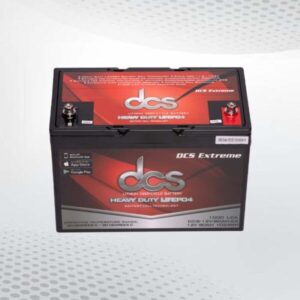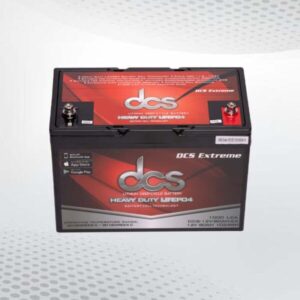Batteries play a vital role in our daily lives, powering everything from our cars to our smartphones. Deep cycle batteries stand out for their unique design and application. Today, we delve into the world of Deep Cycle Battery Gel exploring how they work and uncovering the secrets of the deep-cycle battery gel.
An Overview of Deep Cycle Batteries
Peel back the exterior casing on any piece of technology, and you’ll likely find a battery nestled inside, quietly powering our tech-filled world. But not all batteries are created equal. Enter deep cycle batteries – the unsung heroes providing steady, sustained energy over extended periods.
Deep-cycle batteries are in it for the long haul, unlike their standard counterparts that merely start engines with a sudden energy jolt. These powerhouses truly come into their own when a continuous energy supply is needed, such as in renewable energy storage systems or while keeping your recreational vehicle running on those off-grid adventures.
Whether taking to the high seas in marine applications or living the solar-powered dream, deep cycle batteries provide reliable, consistent power when it matters most.
The Inner Workings of AGM Deep Cycle Battery
Dive into the heart of AGM Deep Cycle Battery, and you’ll discover a compelling blend of technological ingenuity and practical design. At its core, the electrolyte in AGM batteries isn’t free-flowing but rather trapped in a fine mat of glass fibers, thus forming the basis for its spill-proof design.
But the true magic lies in how this unique configuration paves the way for a swifter energy transfer between the electrolyte and the plates. This supercharged exchange, in turn, revs up the battery’s efficiency and performance.
So, the next time you marvel at your AGM deep cycle battery’s endurance and prowess, remember it’s all in the fibers, absorbing, conducting, and powering your adventures with remarkable efficacy.
The Superiority of AGM Deep Cycle over Conventional Batteries
Compared to traditional lead-acid batteries, AGM Deep Cycle is akin to the high-performing athletes of the battery world. They thrive under the demanding conditions of high current outputs and deep discharges. Their robustness isn’t just about power; they also flaunt a greater resistance to shock and vibration.
While a conventional battery might quiver under the impact, your AGM battery stands unyielding and resilient. But the advantages don’t stop at performance. The AGM design also champions safety and environmental friendliness. Thanks to their sealed nature, these batteries eliminate the risks associated with acid spills and gas emissions.
In terms of maintenance, AGM batteries keep it low-key, sparing you the frequent upkeep often demanded by their conventional counterparts. AGM batteries command an impressive edge over traditional options, from power and endurance to safety and low maintenance.
Understanding the Deep Cycle Battery Gel
 Dive into the realm of the deep cycle battery gel, a technological marvel designed for maximum performance. Unlike typical batteries, gel batteries feature a jellified electrolyte. This gooey substance isn’t just for show – it’s a power player in reducing water loss and ensuring superior performance in deep discharge scenarios.
Dive into the realm of the deep cycle battery gel, a technological marvel designed for maximum performance. Unlike typical batteries, gel batteries feature a jellified electrolyte. This gooey substance isn’t just for show – it’s a power player in reducing water loss and ensuring superior performance in deep discharge scenarios.
It’s also a major player in enhancing durability, making gel batteries a strong contender for long-lasting power. This clever concoction isn’t merely content with being robust and efficient.
it also lowers maintenance needs, taking the strain off you and placing it squarely on its gel-filled shoulders. Step into the future of battery technology with the deep cycle battery gel, where superior performance meets unrivalled convenience.
The Pros of Deep Cycle Battery Gel
The brilliance of gel batteries lies in their exclusive characteristics. First, they boast an impressive cycle life – a testament to their staying power. Second, they’re not fazed by harsh temperature swings, maintaining top-tier performance no matter the weather.
Third, they’re tough as nails when dealing with deep discharges and overcharging. If that’s not enough, gel batteries, akin to their AGM siblings, also require minimal maintenance and have a lower risk of leakage.
In a nutshell, they’re practically the superheroes of the battery world, flexing their strengths while minimizing the weaknesses found in conventional batteries.
Choosing Between AGM and Gel Batteries
Are you caught in choosing between an AGM and a gel battery? It’s a common difficulty that comes down to the specifics of your requirements. If you’re seeking power for high-current applications, the rapid energy transfer of AGM batteries will meet your needs perfectly. They’re the thoroughbreds of the battery world, designed for high-speed energy delivery.
However, gel batteries rise if your quest is for a stalwart companion that can withstand low current and deep discharge scenarios. They’re the marathon runners, pacing themselves to go the distance, never faltering even when the power demand is low. Remember, both are league winners—your decision hinges on understanding which league you’re playing in.
And the stakes of this league: what power requirements does your application have, and over what duration? Identifying these specifics will set you on the path to making an informed choice.
Caring for Your Deep Cycle Battery
Like a garden, your deep-cycle battery thrives with a bit of TLC. Regular maintenance is the secret ingredient to a healthy, long-lasting battery. Start with a clean slate – literally! Ensuring your battery is always clean can fend off potential problems.
Charging mishaps can be the Achilles heel of batteries, so sidestep overcharging issues by monitoring your battery regularly. Remember not to use your battery during hibernation periods. Proper storage can differentiate between a swift startup and a sluggish resurrection. A keen eye can be your best tool in battery care.
Regular inspections can catch signs of damage or wear, helping you to nip potential issues in the bud. Remember, your battery is more than just a power source; it’s a power partner. And like all good partnerships, a little care and attention go a long way.
Maximizing Your Battery Lifespan
Imagine your deep cycle battery as a star athlete. Just as an athlete requires consistent training, a balanced diet, and rest, your battery also craves a healthy charging routine for optimal longevity. Discharging your battery excessively is akin to overtraining, leaving it weakened and less effective over time.
It’s equally vital to employ the right equipment – just as an athlete uses appropriate gear for their sport, your battery needs a suitable charger tailored to its specific needs. Additionally, consider the different training requirements of AGM and Gel batteries. Understanding and respecting their unique charging needs will be instrumental in extending your battery’s lifespan.
Remember, your battery’s lifespan isn’t just about how long it lasts but also about maintaining its performance and efficiency throughout its life. So go ahead, put on your coach’s hat and embark on the journey of maximizing your battery’s lifespan.
Comparing Gel Batteries: VRLA vs. Flooded
When sizing gel batteries, the debate between VRLA and flooded types is noteworthy. For many reasons, the VRLA, or Valve Regulated Lead-Acid, gel batteries come out on top. For starters, these batteries are maintenance-free, giving them a user-friendly edge.
They’re sealed, eliminating the possibility of any spillage, making them safe and reliable. Plus, their versatile design can be installed virtually any orientation, allowing you to fit them into even the most unconventional spaces. Meanwhile, flooded types, while having their own merits, often need to catch up in these areas. So, when the choice is between VRLA and flooded gel batteries, VRLA offers the advantage of convenience and dependability.
However, it’s important to note that all gel batteries, including VRLA, require careful handling to prevent damage and prolong their lifespan. Further, understanding the charging process of these batteries can make a world of difference in their performance.
Optimizing Battery Performance through Charge and Discharge Strategies
Mastering the art of charging and discharging your deep cycle battery is akin to striking gold in your quest for optimizing battery performance. Picture this – your battery is a marathon runner. Discharging it below 50% capacity would be like pushing your runner to its limit without giving it a chance to recover.
The result? A weary and less efficient battery. The solution? Always recharge promptly to keep your power marathoner at its peak form. You might be wondering about overcharging. Think of it as overfeeding your athlete, causing sluggishness and decreased performance.
Keep a keen eye on your battery’s charge levels to avoid this pitfall. Essentially, your battery’s performance hinges on your ability to balance the charging and discharging tightrope, ensuring that it neither starves nor overindulges. Remember, in the world of deep cycle batteries, it’s not just about survival but about thriving, and the key to this lies in your charge and discharge strategies.
FAQs
Question: What are deep cycle batteries used for?
Answer: Deep-cycle batteries are commonly used in systems that require a continuous power supply, such as solar energy storage systems, RVs, marine applications, and off-grid energy systems.
Question: How long do AGM and gel deep cycle batteries last?
Answer: These batteries can typically last between 3-7 years with proper care. However, their lifespan significantly depends on their usage and maintenance.
Question: Can I use a regular battery charger on my deep cycle battery?
Answer: While it’s technically possible, it’s not recommended. Deep cycle batteries have unique charging needs, and a suitable charger tailored to these needs is key to maximizing battery lifespan.
Question: Can deep-cycle batteries be used for starting applications?
Answer: While deep-cycle batteries are designed to provide steady, long-term power, they can be used for starting applications. However, they may not perform as efficiently as dedicated starting batteries.
Question: What’s the key difference between AGM and gel batteries?
Answer: The primary difference lies in their electrolyte state. AGM batteries have a fiberglass mat soaked in the electrolytes, while gel batteries use a gelled electrolyte. Their specific use cases differ based on these unique characteristics.
Conclusion
Embarking on a deep dive into deep cycle batteries, we’ve unraveled the mechanics of AGM and gel batteries. AGM batteries shine in high-current applications with rapid energy transfer and low maintenance needs. In contrast, gel batteries excel in deep discharge scenarios, offering durability and consistent performance. Your choice ultimately boils down to your specific power requirements. But remember, no matter your choice, proper care and suitable charging strategies are crucial in optimizing your battery’s lifespan. After all, deep cycle batteries aren’t merely a power source but a steadfast power partner. Here’s to unlocking the power of your deep cycle batteries and powering on to great adventures and sustainable solutions. As technology evolves and we continue to push the boundaries of what’s possible, these batteries will undoubtedly be at the heart of it all, quietly powering our world, one cycle at a time.
| Other Good Articles to Read |
| Blogs Rain |
| Cme Blog Spot |
| Garcias Blogs |
| Yyc Blogs |
| Guiade Blogs |
| Blogs-Hunt |
| Impact-Blog |
| Smarty Blogs |
| Ed Blog |
| Mo Blogs |
| Blogs Em |
| Blogs T |



